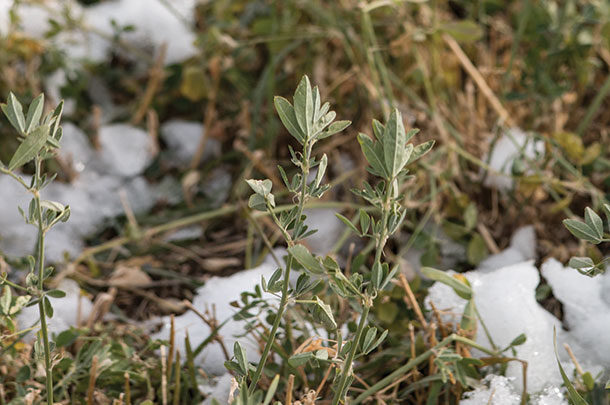Fall dormancy is the ability of alfalfa to grow in the fall. It is determined by clipping alfalfa about 25 to 30 days before a killing frost (generally mid-September to mid-October, depending on location) and measuring the height of regrowth near frost.
Then the variety is given a rating relative to the growth of checks (Table 1). The most-dormant types (fall dormancy 1) will remain very short, and the least-dormant types (fall dormancy 11) will grow as much as a couple of feet tall.
 Generally, less-fall-dormant types (those with a higher fall dormancy number) tend to yield more because less-fall-dormant types start growing earlier in the spring and start regrowing faster after harvest.
Generally, less-fall-dormant types (those with a higher fall dormancy number) tend to yield more because less-fall-dormant types start growing earlier in the spring and start regrowing faster after harvest.
Winter hardiness is a measure of the alfalfa plant’s ability to survive the winter without injury. With the shorter day lengths and cooler temperatures of fall, alfalfa plants change their physiology and structure to better survive freezing temperatures and dessication associated with winter.
A greater extent of this acclimation allows plants to survive more severe winters. However, this acclimation limits forage production. So we want sufficient winter hardiness to have alfalfa survive the winter without injury, but additional winter hardiness costs yield with no additional winter survival benefit.
When we say winter hardiness, most think of the alfalfa not being killed over winter. While this concern is real, the most frequent and greatest loss often comes from plants that survive winter but are injured. Alfalfa forms buds in the fall for spring growth.
If a significant number of those buds are killed over winter, the plant must start over forming buds in the spring. This delays spring growth and results in a yield loss. This injury is visible when the stand is 6 to 8 inches tall in the spring.
If all stems are about the same height, there was no injury; if some stems are about 3 inches taller than others, those buds survived the winter, and the shorter stems are from buds that were formed in the spring and will yield less on first cutting.
Note that we use the term “winter survival” rather than “winter hardiness” in the score system (Table 2).
 Technically, “winter hardiness” refers to plant physiology, and “winter survival” is a broader term including other factors that can injure or kill alfalfa.
Technically, “winter hardiness” refers to plant physiology, and “winter survival” is a broader term including other factors that can injure or kill alfalfa.
We started this article saying that plant breeders had broken the relationship between winter hardiness and fall dormancy, but that is only true over 2 to 5 fall dormancies.
Over this range, fall dormancy and winter survival used to be about equal. Now we have some fall dormancy 5 alfalfa varieties that have a winter survival score of 2 or less.
So how do you choose? The general principle is: The least-fall-dormant variety that will survive the winter will provide the most yield.

So look at your stands; if all are uniform height on spring greenup, then winter survival score is adequate and you could explore slightly less winter hardiness. If stands are uneven in the spring, then a lower winter survival score is needed. The actual winter survival score you need depends on the severity of the winter.
Areas with good and consistent snow cover need less winter hardiness than areas with open periods over winter.
In addition, management can play a role in the winter hardiness needed. If potassium and sulfur are not in optimum ranges, or soil pH is below 6.8, stands will suffer winter injury and kill more frequently. Also, less fall dormancy can allow harvestable yield to accumulate in the fall growth prior to frost.
This can produce more economic return but also stresses the plant and requires more winter hardiness. Some areas can take the late fall cutting with little risk due to good snow cover and other factors, while taking this cutting is risky in other areas.
Additionally, while fall dormancy does not directly relate to winter survival over the fall dormancy 2-to-5 range, the less-dormant plants do break dormancy faster and begin growth.
Thus, if a region has two days of 60ºF or 70ºF weather in January, the 2 to 4 fall dormancy varieties will not break dormancy – but a 5 or 6 fall dormancy variety might. The variety that breaks dormancy in January might winterkill or at least have buds kill and reduce first cutting yield.
Some regions have this weather, and some do not. Some will also have snow cover on the warm days, which will reduce the dormancy breaking.
Thus, we have a fall dormancy range of 1 to 11 and a winter survival range of 1 to 6. How do you choose alfalfa varieties when considering these two factors?
If producers are located in Southern regions, winter survival is not an issue, and you should grow fall dormancy 8 to 10 varieties for season-long growth (choose among types based on disease and pest resistance).
If producers are located in Northern regions, then winter survival is an issue. Decide how much winter survival you need based on your climate and management. The best assessment is to see how stands have been surviving and choose a winter survival score accordingly. Then consider fall dormancy: The higher the number, generally the higher the yield.
But this too must be adjusted to your management system. If the fall dormancy score is so high the stand starts to regrow before you have removed the cutting, you will drive over the regrowth, breaking off stems and reducing yield of the next cutting.
Recommendations for fall dormancy versus harvest speed are shown in Table 3.

All producers will have some conditions where alfalfa takes longer to get off the field, and then the traffic damage to regrowth is an additional factor to the bad harvesting conditions. When using the table, consider what average time the alfalfa lays on the field before being harvested.
In addition to considering fall dormancy and winter survival, when selecting alfalfa varieties always consider the disease and insect resistance, especially if you have a particular problem such as nematodes.
A listing of alfalfa varieties with fall dormancy and winter survival rating, as well as disease resistances, is available online (National Alfalfa & Forage Alliance). Select “Education” and then “Alfalfa Variety Ratings.” ![]()
PHOTO 1: Confused about fall dormancy and winter hardiness? If your alfalfa is slow to green up in spring, which factor do you adjust?
PHOTO 2: When we say winter hardiness, most think of the alfalfa not being killed over winter. While this concern is real, the most frequent and greatest loss often comes from plants that survive winter but are injured. Photos by Lynn Jaynes.

-
Dan Undersander
- Forage Agronomist
- University of Wisconsin
- Email Dan Undersander













